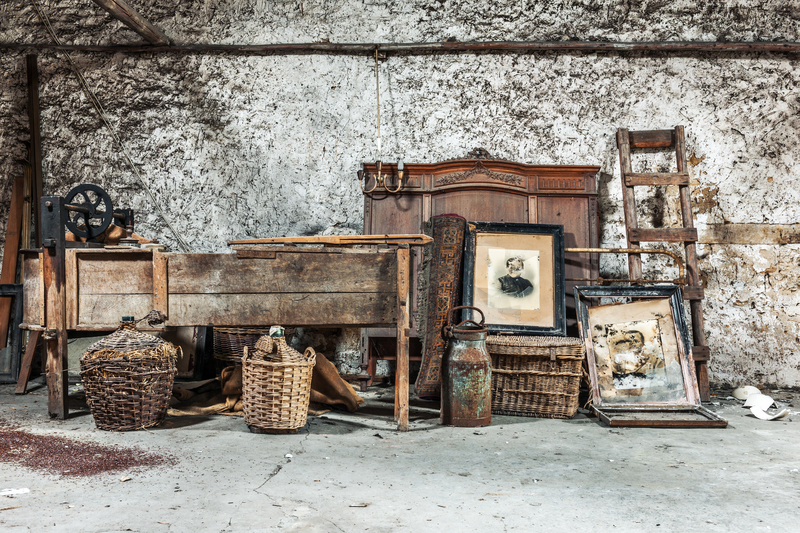Essential Tips for Packing during Your House Move
Posted on 18/05/2025
Essential Tips for Packing during Your House Move
Moving into a new home can be an exciting new chapter, but it can also bring ample stress if you're unprepared. Packing, in particular, is often considered one of the most daunting tasks. However, with a strategic approach and expert advice, your house move can become a streamlined, hassle-free experience. This comprehensive guide will provide you with essential tips for packing during your house move, ensuring your belongings are safe and the process is as efficient as possible.

Why Proper Packing Matters for Your House Move
Packing isn't just about putting your things in boxes--it's about protecting your valuables, staying organized, and setting the stage for a smooth transition. By following the right packing tips for moving house, you'll not only safeguard your possessions but also significantly reduce relocation anxiety for the whole family. Whether you're a first-time mover or a seasoned pro, revisiting packing strategies can make all the difference.
Planning Ahead: The Key to a Successful House Move
1. Start Early and Create a Packing Schedule
One of the most crucial house moving packing tips is to start early. Procrastination only leads to last-minute chaos. Begin packing at least 4-6 weeks before your move, starting with items you use infrequently.
- Devise a packing plan: Allocate certain rooms or items to pack each week to avoid overwhelming yourself.
- Set daily/weekly goals: Use checklists to track progress and stay motivated.
- Start with non-essentials: Pack out-of-season clothes, books, and decorative items first.
2. Gather the Right Packing Supplies
Investing in quality materials helps prevent damage and keeps your process running smoothly. For effective packing for moving house, make sure you have:
- Sturdy moving boxes in various sizes
- Bubble wrap, packing paper, and foam peanuts for fragile items
- Heavy-duty packing tape and a tape dispenser
- Permanent markers and labels for clear identification
- Scissors and box cutters for easy opening and sealing
- Blankets or pads to protect furniture
Remember, reusing old boxes can save money but may compromise on durability. For valuable or delicate objects, always opt for new, sturdy packaging.
Declutter Before You Pack
3. Sort and Simplify Your Belongings
One of the most powerful packing tips for house moving is to declutter before you box anything up. Moving is a prime opportunity to let go of unwanted possessions.
- Create categories: Keep, Donate, Sell, and Trash.
- Be ruthless: If you haven't used it in a year, consider letting go.
- Organize a garage sale: Earn extra cash and lighten your load.
- Donate to local charities: Gently used items can benefit others in need.
Decluttering not only saves space in the moving truck, but also cuts costs and effort at your new home.
Packing Room by Room: Strategies and Techniques
4. Pack One Room at a Time
Maintain order and minimize confusion by focusing on one room at a time. Label boxes clearly by room and contents--it makes unpacking a breeze.
- Start with least-used rooms: Guest rooms, basements, attics.
- Finish with everyday spaces: Kitchen, bathrooms, and bedrooms.
- Label everything: Include details like "Kitchen - Pots and Pans" for quick reference.
5. Special Tips for Packing Fragile Items
Fragile items require special attention to prevent breakage during transit. Follow these essential packing tips for glassware, dishes, and collectibles:
- Use plenty of padding: Wrap each item individually with bubble wrap or packing paper.
- Fill empty spaces: Use crumpled paper or towels to prevent shifting inside boxes.
- Double-box valuables: Place small boxes inside larger ones, cushioned with foam or peanuts.
- Clearly mark boxes as "Fragile": Alert movers to handle with care.
6. Clothes, Shoes, and Personal Accessories
- Wardrobe boxes: These come with built-in hanging rods for clothes on hangers, minimizing wrinkles.
- Use suitcases: Pack heavy items like books in rolling suitcases for easier transport.
- Keep shoes in original boxes: Or, pad them with socks to retain shape.
7. Kitchen Packing Techniques
- Use small boxes for dishes: Plates are heavy--avoid overloading.
- Bundle cutlery together: Wrap sharp knives in dish towels for safety.
- Pack pantry items thoughtfully: Avoid packing open containers to prevent spills.
- Defrost and drain appliances: Clean out the fridge and freezer 24 hours before moving.
8. Electronics and Appliances
- Backup important data: Save files on external drives or the cloud in case of accidents.
- Cord management: Use zip ties and label cords for quick reassembly.
- Original packaging, if possible: Use manufacturers' boxes for best protection.
- Secure doors and removable parts: Tape doors shut to prevent damage in transit.
Expert Packing Tips: Making the Moving Process Easy
9. Don't Overload Boxes
Heavy items should go in small boxes, lighter items in larger ones. This ensures boxes aren't too cumbersome to lift or carry and prevents accidents. Aim for a maximum box weight of 20-25kg (45-55lbs).
10. Utilize Space Wisely
- Fill gaps: Use linens, towels, or clothes to pad spaces between objects.
- Stack items strategically: Place heavier items at the bottom and lighter, more delicate ones on top.
- Disassemble furniture: Take apart bulky pieces to maximize van space and reduce damage risk.
11. Label, List, and Photograph
Labelling is a non-negotiable when it comes to efficient house moving packing. Number your boxes and keep an inventory list for easy tracking. Additionally, photographing the back of electronics or complicated assemblies can save time reassembling later.
Essentials Box: Don't Forget the First Night Kit!
After a long moving day, you won't have the energy to sift through dozens of boxes for necessities. That's why one of the most commonly recommended packing tips for moving house is to prepare an essentials box:
- Change of clothes for each family member
- Toiletries: Toothbrush, toothpaste, soap, shampoo, shower items
- Medications and basic first aid
- Chargers for phones and devices
- Snacks, bottled water, and basic kitchen supplies
- Important documents and valuable items
Your first night kit ensures you have comfortable access to basics before you start unpacking everything else.
Time and Money-Saving Packing Tips
- Enlist help: Don't be afraid to ask friends or hire packers. Many hands make light work.
- Use what you have: Laundry baskets, suitcases, and reusable grocery bags make excellent moving containers.
- Keep hardware together: Put screws and bolts from furniture into labelled bags, tape them to the matching item.
- Take photos of complex setups: Especially for entertainment systems or intricate shelving units.
- Cancel and transfer utilities ahead of time: Avoid last-minute disruptions!
Hiring Professional Packers vs DIY Packing
When considering the most effective tips for packing during your house move, it's wise to weigh the pros and cons of hiring professionals. Professional packers bring expertise, advanced materials, and speed. However, DIY packing gives you total control and helps you cut costs. If you choose a moving company, ask about their packing services and insurance for your peace of mind. For fragile, heavy, or valuable items, sometimes the extra investment is worth it!
Stay Organized Throughout the Move
Final Checklist for Successful House Move Packing
- Finish packing one to two days before moving day to avoid last-minute stress.
- Use a moving binder or digital folder to keep track of receipts, checklists, and important documents.
- Double-check all labels and room assignments for clarity when unloading.
- Communicate with movers about fragile or high-priority boxes.
An organized and well-communicated plan means less work and confusion upon arrival at your new house.
Common Mistakes to Avoid While Packing for Your House Move
- Leaving it too late: Last-minute packing leads to errors and broken items.
- Mixing items from different rooms: Makes unpacking slow and confusing.
- Ignoring box weight limits: Leads to injuries and box breakdowns.
- Skipping labels: You'll lose track of what's where.
- Not preparing an essentials box: Causes inconvenience and frustration on the first night.

After the Move: Unpacking and Settling In
Congratulations--once you've reached your new home, you're almost there! Prioritize unpacking by room (essential spaces first), check each box against your inventory list, and reassemble furniture using your labelled parts and photographs. Recycle or repurpose moving boxes to reduce waste, and don't forget to update your address with banks, services, and friends.
Conclusion: Make Your House Move Stress-Free with Smart Packing
With these essential tips for packing during your house move, you can turn a potentially stressful experience into a manageable, even rewarding one. The key to successful house moving and packing is simple--stay organized, plan ahead, and protect your belongings with care. Whether you choose to hire professionals or tackle the task yourself, strategic packing will ensure your new home adventure starts right!
Are you planning a move soon? Bookmark this page and follow these expert house move packing tips for a smooth, efficient, and stress-free transition. Happy moving!
